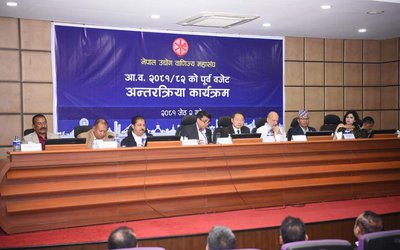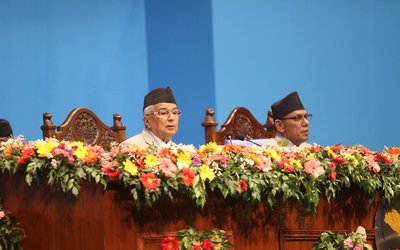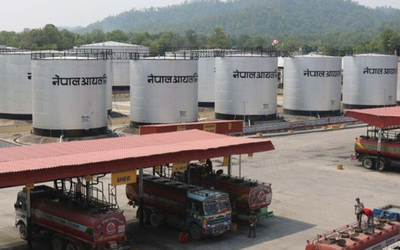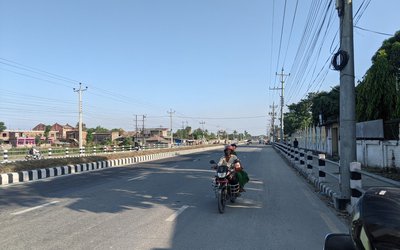
Many people, including his relatives, were startled when Rajesh Maharjan, a resident of Lalitpur Metropolitan City (LMC), opted to use hollow clay brick in his new home. Maharjan carried out his decisions with the support of his family, notably his wife Kalpana Shrestha.
As someone who has worked in the development sector for a while, Maharjan selected hollow clay bricks because they are a recent innovation that is less expensive, energy efficient, light in weight, and environmentally beneficial.

The first building made of hollow bricks is Maharjan's three-story multipurpose structure, which is located in Gwarko, Ward No. 9 of the LMC. The newly constructed structure, which is currently in the finishing stages, serves as a model for learning about the cost, benefits, and long- and short-term advantages of using hollow bricks.
Hollow clay brick has a reputation for being a cost-effective, environmentally friendly, and resource-efficient building material.
But no matter how many buildings are built, neither one nor ten will make the product economically viable or considerably aid in the reduction of emissions. A sizable market is required for mass production. The three tiere of governments must all make policy changes in this building construction area and consumers must be made aware of the hollow brick's strength.

BUILDING Energy Efficiency in Nepal (BEEN), a four-year project funded by the European Union under the SWITCH-Asia Program and led by the University of Innsbruck, Austria in collaboration with MinErgy Pvt Ltd, Nepal, Greentech Knowledge Solutions Pvt Ltd, India, and Asociación Espaola de Normalización (UNE), Spain, aims to transform the use of brick in Nepal from traditional brick to modern energy efficient hollow brick.
"Research and tests have previously established the resource-efficiency of hollow Brick. Brick is extensively used all over the world and uses less clay and coal, reducing the production of hazardous pollutants like carbon dioxide. According to studies, a brick with a 15% hollowness can save up to 24% clay and up to 30% fuel. Tubular hollow cavities increase insulation, which helps to lower energy costs for maintaining thermal comfort during building operation. If a room is constructed using hollow bricks rather than solid ones, it is predicted that up to 5% of the energy used for air conditioning will be saved,” said Suyesh Prajapati, team leader of the BEEN project.
"Hollow brick manufacture and use can drastically save fuel costs for brick entrepreneurs, energy expenses for building occupants, and eventually provide economic benefits to the country. Brick kiln emissions are also reduced by the reduction in coal consumption. In addition to stressing the technical, market, and contributions of hollow bricks to emissions reduction in urban settings, Prajapati noted that their application resulted in a reduction of structural load in the building and a reduction in building construction costs because of its lower weight,” Prajapati added.
Despite having so many benefits, it is not yet a widely used product in Nepal. Hollow brick has yet to enter the market due to a lack of marketing initiatives, proper knowledge of hollow bricks, and government policy.
"Hollow brick provides a lot of advantages. The structural load can be decreased by using hollow bricks. Moreover, it is less expensive than other bricks. The building will consume less energy to heat and cool because of the hollow brick," said Maharjan, the homeowner.
From a long time ago, hollow clay bricks have been produced in Nepal, however, the amount of bricks produced has been quite small. Chiribabu Maharjan, the mayor of Lalitpur Metropolitan, asserts that he built his home in Sanepa, Lalitpur, in 2014 using hollow bricks. Nonetheless, there is still a very minor gap between the supply and demand for hollow brick—less than 100,000 each year.

The first large-scale commercial manufacture of hollow clay bricks has begun in Nepal after being jointly launched last month at the Hosanna Brick Factory in Harisiddhi by the mayor of Lalitpur Metropolitan City (LMC), Chiri Babu Maharjan, and the ambassador of the European Union to Nepal, Nona Deprez.
With a production capacity of over two million bricks annually, Hosanna Brick Factory is now offering various sizes of hollow bricks. The factory installs modern types of equipment with an investment of over Rs.20 million. The hollow brick produced by the factory will be available in the market as per the demand of consumers.
Of the 100 brick factories in the valley, the Hosanna Brick Factory in Harisiddhi, 10 kilometers southeast of Kathmandu, was chosen to begin commercial production and marketing initiatives. The factory is in charge of the effort to bid goodbye to Nepal's century-old, emissions-heavy traditional clay brick. The factory is the most qualified candidate to lead, given its 20 years of experience in traditional brick production and promotion.
The manufacturing of 2 million bricks will initially have a minimal impact on the market and would help to reduce emissions, but Nepal produces 5.14 billion bricks on average annually. Annual CO2 emissions from brick manufacture are 1.2 million tons.
Nonetheless, since the brick sector in Nepal is one of the major consumers of coal, any action taken to substitute coal or reduce its use will have a long-term positive impact on the environment. A large number of harmful emissions are produced each year by 1340 brick factories in Nepal, which use roughly 504,000 tons of coal and hundreds of tons of biomass.
The event, which was launched in front of elected representatives, government officials from the federal, provincial, and municipal levels, as well as brick producers on January 20, has begun a new chapter in the history of Nepal's brick manufacturing.
The owner of Hosanna Brick Factory, Krishna Awale said that his factory could meet all consumer demands for hollow brick for now. "Our existing capacity is sufficient to meet market demand. To develop the market for our products, we do, however, need assistance from all levels of government. The federal government ought to change its housing regulations to permit the use of hollow brick in the construction of public structures,” said Awale.
Building Energy Efficiency Nepal (BEEN) Project has launched promotion activities in close collaboration with local levels, the Ministry of Federal Affairs and General Administration, the Department of Urban Development and Building Construction (DUDBC), the Alternative Energy Promotion Center, NGOs, the Brick Factory and Brick Producer Association.
It is anticipated that the practice of employing the traditional brick and replacing it with hollow brick would change given the broader involvement of different stakeholder groups.
At a time when urbanization is speeding up, the official promotion campaign, which will cover 60 municipalities all over four bio-climatic zones in Bagmati, Lumbini, and Gandaki provinces, was a watershed moment in promoting energy-efficient buildings.
Creating Market
Around 6 billion bricks are needed annually for the Nepalese construction market, but the only options available up until now have been traditional clay bricks, hollow cement blocks, and a few other partition materials. Even the government's policies, rules, and directives place limitations on the use of hollow bricks.
In light of this, hollow brick, which has just entered the market formally, will need to win over new customers like Maharjan in addition to gaining the support of the Ministry of Urban Development, and the Department of Urban Development and Building Construction (DUDBC), Provincial Government, local governments.
Awale, the owner of the factory, believes that a promotion campaign and policy-level action are essential to popularizing the hollow clay brick. He advocated for the necessity to widely broadcast communications outlining the power and advantages of this technology.

Lower pricing, meanwhile, may still draw some buyers. Maharjan, a homeowner, believes that a product's pricing can have a significant impact on the market. Maharjan, despite the reduced production cost, paid a comparable price.
Entrepreneurs asserted, however, that as demand rises, prices will gradually decline. Initially, purchasers will pay the same price as a typical brick due to the early stages of manufacture. Prices should decrease if the company starts producing in large quantities, according to Awale.
Industrialists in the brick industry are more eager to adopt innovations even when the market has not yet been created. President of the Association of Nepalese Brick Industry Shankar Bahadur Chand stated, "this is a future for us, and we are prepared to switch to hollow brick". To encourage hollow clay brick, the policies must be changed, though. By changing the regulations at all three tiers of government, the market must provide for us incentives for hollow bricks.
Urbanization in Nepal
In South Asia, Nepal is one of the nations that is urbanizing quickly. Unplanned urban sprawl and haphazard building development have both increased energy usage. The study found that heating and cooling absorb 60% of the energy used in Kathmandu's modern structures. Building stock has a larger carbon footprint since it is made of materials with a high embodied energy.
According to census figures from 2021, urban regions housed 66.08 percent of the population. If Nepal doesn't take immediate action to alter the way buildings are built in metropolitan areas, a tremendous amount of energy will be needed.
To promote an energy-efficient urban development that creates safe, green, healthy, and resilient places, BEEN is calling for innovative pledges from new environmentally friendly and cost-effective construction materials like hollow brick, which are highly relevant to Nepal.
"Hollow bricks will be used to reduce everything. Because hollow bricks require less energy and clay during production, they are environmentally benign. Hollow bricks promote thermal comfort. It keeps the interior walls of the structure warm in the winter and cool in the summer. In order to make the building more earthquake-resistant, hollow brick can be used,” said Prajapati.
In Nepal, bricks are fired using 504,750 tons of coal per year, according to an ICIMOD report from 2018. The ability of hollow bricks to retain clay and fuel is one of their main advantages. The hollowness determines fuel savings. According to studies, a brick with a 15% hollowness can reduce fuel and clay usage by up to 30% and by up to 24%, respectively.
Entrepreneurs contend that once the speed of construction picks up in the countries and consumers become aware of the cost and strength of the hollow brick, the demand and supply chain issues will manifest themselves right away.
Because of the rising cost of coal, brick manufacturers are losing money on investments in traditional brick production. “Several factories might use this new technology if an acceptable hollow brick policy is released. Standard rules and regulations are now missing for the promotion of hollow brick,” claimed Chand.
Hollow Brick, which was first used commercially in Nepal fairly recently and is intended to help with pollution control, is still a new product. BEEN, a four-year project, will make difference.
The use of hollow brick will significantly help Nepal reach its ambitious goal of zero emissions by 2050, as was outlined in its Nationally Determined Commitment (NDC).

Both load-bearing and non-load-bearing building can use clay hollow burned bricks. Also, clay hollow bricks have a high level of durability and are widely employed in a variety of appropriate applications, according to Prajapati. "Once people are aware of all the advantages, demand for hollow brick increases. The benefits of brick are currently only known by a small number of individuals, though."
Customers have no information about hollow clay brick because the market is dominated by traditional clay brick and other materials, and they rarely choose the brick because of this ignorance.
“In general, the average cost of a hollow brick is between Rs. 17 which is similar to the traditional brick. It has a different shape but more attractive is a Cube shape. The bricks are durable, thermal," said Awale.
"In general, a hollow brick costs around Rs. 17, which is comparable to a regular brick. Although it has several shapes, the cube shape is more appealing. The bricks are strong and thermal, according to Awale.
The lack of national standards, a lack of consumer knowledge, and the capacity of the brick industries present serious obstacles to the marketing of hollow bricks in Nepal, according to Prajapati.
Policies On Hollow Brick
Additionally, according to Prajapati, Nepal lacks norms, directives, and laws. The main prerequisite is the adaption of the national construction code, which emphasizes low-carbon and climate-resilient urban settlement in all municipalities.

According to officials at the Ministry of Urban Development, a federal agency responsible for regulating the quality and standard of building materials, including brick, the present building codes, building guidelines, and building policies are sufficient to support hollow brick.
"Local governments have jurisdiction over matters pertaining to the creation and enforcement of building codes as well as the specification of requirements for building materials, including hollow brick. Only technical instructions can be issued by the Ministry of Urban Development, according to joint secretary Rajendra Dangal. The building construction handbook advises using lightweight materials while constructing buildings. This refers to the use of clay hollow bricks. The Ministry, however, cannot compel local or provincial governments to utilize a particular brick or materials. The Ministry is enthusiastic about promoting hollow brick because it is an environmentally beneficial and energy-efficient brick that can support Nepal's objective of zero emissions.
The National Urban Policy mandates the use of environmentally friendly materials in building development, according to Department of Urban Development and Building Construction (DUDBC) spokesperson Pratigya Manandhar. All materials that promote the National Housing Policy are given precedence because its goal is to create a clean, safe, and prosperous urban environment, according to Manandhar.
The National Urban Policy of 2007 outlines the development of a building construction system that is safe, environmentally friendly, and accessible to the general public in Strategy 4.2.9 subclause 3.2.9 (a).
To develop alternative building materials and construction technologies, Safe Citizen Housing Implementation Process 2075 encourages technology to research, development, and application while placing a strong emphasis on locally accessible traditional skills and expertise.
Despite these provisions, the government has not yet approved the use of hollow brick in the construction of public buildings. "I want the new LMC building to use hollow brick. But DUDBC regulations prevent us," LMC mayor Chiribabu Maharjan said. "Hollow brick is cheap, safe, and environmentally beneficial, yet I can't use it."
Different opinions are held by Ministry of Urban Development employees. The DUDBC must be consulted and given prior clearance for any local decisions about the materials, according to joint secretary Dangal.
Entrepreneurs in the brick industry contend that a significant change in DUDBC policy is necessary to expand the brick market. "The construction of public buildings uses a lot of bricks. Awale, a businessman, asserted that adding clay hollow brick to the list of materials will revolutionize the game.
With the transition from conventional Nepali brick to energy-efficient hollow brick, the introduction of hollow brick marked a turning point in Nepal's history of brick production.
"In addition to Kathmandu, Lumbini Province's Kapilvastu has also started producing hollow bricks. The production of bricks will also begin at a factory in the Gandaki Province with help from BEEN and in coordination with the Nepalese Brick Industries Association, according to Prajapati.
Hollow bricks are crucial for lowering buildings' carbon footprints and creating a low-carbon, resource-efficient building construction industry in Nepal.
"After participating in activities, I feel inspired. Hollow bricks are utilized all over the world. I'm extremely happy to have representatives from many levels of government and organizations here. The fact that this initiative collaborates with other projects is important to highlight. Instead of overlap or gaps, I'm hoping for synergy, stated Ambassador Nona Deprez.
The department's deputy director general, Jyoti Joshi, who is in charge of standards and metrology in Nepal, provided an update on the Nepal Standard for hollow bricks. Joshi stated: "The work to compare Nepal Standard to hollow brick has already begun.
Consumers Awareness
The hollow clay brick, which has several benefits for customers in terms of cost, technology, and environmental effects, has to be made more widely known to consumers.
"To better inform consumers that purchasing this brick is in their long-term best interests as citizens since it affects the quality of the air we breathe and our health, is what is required right now. It all comes down to how well our planet, where we all live, is doing in the end. If we can all contribute in some tiny way to lowering air pollution and harming fuel efficiency, we will all benefit as citizens "in line with Deprez.
Maharjan, the mayor of LMC, has declared that the city will push for the use of hollow bricks in all new construction. "I will take all necessary actions to enforce the use of hollow clay brick," said Mayor Maharjan.
BEEN Project will support the capacity building of micro, small, and medium enterprises (MSMEs) by creating enabling policy and financing environments and increasing market share for energy-efficient and resource-efficient goods and services. BEEN Project has been launched to facilitate the transition towards a low-carbon, resource-efficient, and circular building sector.

Keshab Poudel
Poudel is the editor of New Spotlight Magazine.
- JAPAN’S FM KANIKAWA’S VISIT TO NEPAL: Strengthening Friendship
- May 13, 2024
- SAMRIDDHI: IFAD/MoICS Partnership With Local Governments
- May 13, 2024
- SAMRIDDHI: IFAD/MOICS COLLABORATION Reducing Reliance on Remittances
- May 10, 2024
- SAMRIDDHI: IFAD AND MoICS: Transformation of Subsistence Agriculture Through Women
- May 06, 2024
- IFAD/MoICS’s SMRIDDHI: Retaining Returnee Workers
- May 03, 2024
















